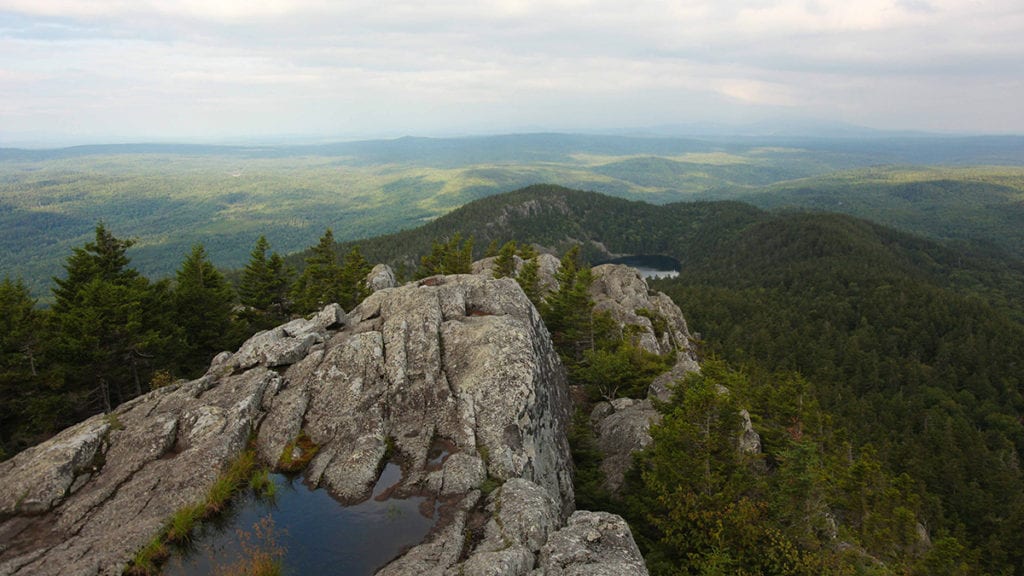
Encompassing almost 1,600 acres in Maine’s Hundred Mile Wilderness region, Borestone Mountain Audubon Sanctuary offers a spectacular array of natural features, including rare older forest, three crystalline ponds (Sunrise, Midday, and Sunset), exposed granite crags, and sweeping, panoramic views.

A seasonal trailside Visitor Center on the shore of Sunrise Pond includes interactive displays, historical information about the area, and a small Nature Store. Also at the sanctuary, on the shores of Sunset Pond and accessible only by boat or on foot, historic Adirondack-style lodges accommodate rentals for groups of up to 24 people as well as public nature programs, from June to October. Trails from the entrance offer popular, family-friendly hikes through the sanctuary and to the summit of Borestone Mountain.
Volunteers play an important role in maintaining the sanctuary and especially the lodges. Read about the special contributions made by the East Sangerville Grange in this Volunteer Spotlight.
Directions & Contact
Borestone Mountain Audubon Sanctuary
Bodfish Valley Road, Elliotsville, ME
From Bangor or Portland, take I-95 to Newport (Exit 157 from the south, or Exit 159 from the north). Follow Route 7 north to Dexter, then take Route 23 north to Guilford. In Guilford, turn left onto Route 15/6 to Monson. After passing through the village of Monson, turn right onto Elliotsville Road. After 8 miles turn left, after the bridge, onto Bodfish Road. Parking area is approximately .7 miles on the left, after the railroad tracks. The gate and trailhead are on the right. Borestone Mountain Audubon Sanctuary is located on Map 41 of Delorme’s Maine Atlas.
Maine Audubon sanctuaries are free and open to the public year round, dawn to dusk (there is a small trail use fee for nonmembers at Borestone). Dogs, even while leashed, are not allowed in our wildlife sanctuaries, as their presence can be disruptive to wildlife.
Visitor Center and Nature Store is open daily in the summer, 9 am-3 pm and has bathrooms, picnic tables, and is a great place to hang out!
For questions about Borestone, call
- 207.781.2330
Trails
Among Maine’s most popular hiking destinations, Borestone Mountain offers a moderately strenuous climb that culminates with spectacular 360-degree views from two peaks at nearly 2,000 feet. With binoculars, hikers sometimes see moose feeding below. Connected trails are marked with blazes and lead 2.5 miles from the sanctuary entrance on Bodfish Valley Road to the top of the mountain.
Downloadable Trail Guide/Map (pdf)
View the Borestone Trail Map on Maine Trail Finder.
Base Trail: This 1.1-mile trail begins from the shale-covered access road, at the first kiosk to the left. A moderate climb through mature forest, it winds back to the access road, which continues another 0.2 mile to the Visitor Center at Sunrise Pond. Hikers may also walk up the access road 1.3 miles from the entrance to the Visitor Center. An overlook offers an expansive view of Greenwood Pond.
Summit Trail: From the Visitor Center, the 1.0-mile Summit Trail follows Sunrise Pond’s shore before climbing steeply through spruce and, in its final stage, over exposed rock. The 0.7-mile trail includes 130 stone steps and two steel handholds before reaching West Peak; continue another 0.3 miles to East Peak.
Fox Pen Loop Trail: This trail stems from the Summit Trail about 0.1 miles from the visitor center. The 0.4-mile trail meanders down to a marsh area. Boardwalks traverse the marsh to the far side where there are remnants of fox pens just beneath an exposed wall of rock.
Peregrine Trail: This 0.5-mile trail begins opposite the Visitor Center and leads gradually upwards above a series of cliffs that overlook the three ponds. Just under 0.2 miles into the trail there is a fork in the trail; stay to the left (the trail right is for staff only). The trail ends at a ledge above the cliffs. (May occasionally be closed. Check with Nature Center staff.)
Trail use fees help Maine Audubon maintain the trails at Borestone:
- $5/nonmember adults
- $3/nonmember students, seniors, and each participant from school and other groups
- Free for Maine Audubon members and children under six
- Use the Venmo QR code and pay ahead of your visit
Wildlife & Habitat
Borestone Mountain Audubon Sanctuary is near the southern end of Maine’s “100-Mile Wilderness” forest. Uncut for more than a century, its forest is unlike much of the region’s spruce-fir and northern hardwood forest, which has been cut for timber every 50-70 years. Lack of mature forest habitat in Maine makes Borestone a special sanctuary for wildlife.
Particularly in early summer, birders can look for Yellow-bellied Sapsucker, Red-breasted Nuthatch, Boreal Chickadee, several vireos, Winter Wren, Hermit Thrush, White-throated Sparrow, and eight to ten warbler species (including Blackburnian, Cape May, and Bay-breasted). Common Ravens and Turkey Vultures regularly soar above the mountain’s exposed granite summit, while Peregrine Falcons appear along the cliff faces.
Borestone’s three clear and deep, spring-fed alpine ponds are fishless, offering unique habitat for a wide range of other wildlife, including beavers and dragonflies and possibly otter. Although fish-eating birds are uncommon at the ponds, Borestone visitors sometimes hear loons calling from nearby Lake Onawa. Visitors also can see and hear bullfrogs, Leopard Frogs, Gray Tree Frogs, and Red-spotted Newts.
Lining Borestone’s trails are blueberry and hobble bushes, as well as wildflowers ranging from early-blooming dog-tooth violet to late-flowering whitewood aster. Mushrooms proliferate in early fall. A variety of mosses and lichens grow in wet areas and on rocks throughout the sanctuary.
History
In the early 1900s, Robert T. Moore managed a fox ranch on what is now Borestone Mountain Audubon Sanctuary. Aided by the Canadian Pacific railway station on the edge of his land, he sold award-winning pelts to auctions in New York. In 1909, Moore hired noted Bangor architect Wilfred E. Mansur to design the Adirondack-style lodges on Sunset Pond. Lodge guests today can still savor quiet evenings in front of a stone hearth or on porches overlooking ponds.
Moore bequeathed Borestone to the National Audubon Society in 1958, and gifts by his son and daughter and other donors enlarged the sanctuary to its present 1,639 acres. In 2000, the National Audubon Society transferred Borestone Sanctuary to Maine Audubon. Today, it is the centerpiece of Maine Audubon’s north woods presence. Thanks to the surrounding community’s support and involvement, more than 4,000 hikers every year have access to this treasured mountain.
